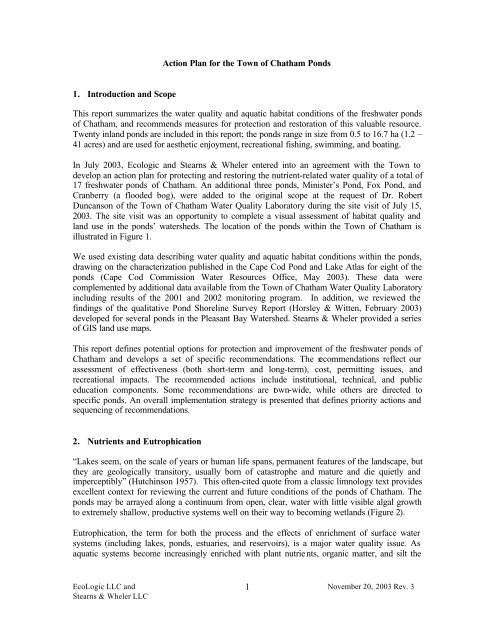Action Plan for the Town of Chatham Ponds
rev 3a report.pdf - Town to Chatham
rev 3a report.pdf - Town to Chatham
Create successful ePaper yourself
Turn your PDF publications into a flip-book with our unique Google optimized e-Paper software.
<strong>Action</strong> <strong>Plan</strong> <strong>for</strong> <strong>the</strong> <strong>Town</strong> <strong>of</strong> <strong>Chatham</strong> <strong>Ponds</strong><br />
1. Introduction and Scope<br />
This report summarizes <strong>the</strong> water quality and aquatic habitat conditions <strong>of</strong> <strong>the</strong> freshwater ponds<br />
<strong>of</strong> <strong>Chatham</strong>, and recommends measures <strong>for</strong> protection and restoration <strong>of</strong> this valuable resource.<br />
Twenty inland ponds are included in this report; <strong>the</strong> ponds range in size from 0.5 to 16.7 ha (1.2 –<br />
41 acres) and are used <strong>for</strong> aes<strong>the</strong>tic enjoyment, recreational fishing, swimming, and boating.<br />
In July 2003, Ecologic and Stearns & Wheler entered into an agreement with <strong>the</strong> <strong>Town</strong> to<br />
develop an action plan <strong>for</strong> protecting and restoring <strong>the</strong> nutrient-related water quality <strong>of</strong> a total <strong>of</strong><br />
17 freshwater ponds <strong>of</strong> <strong>Chatham</strong>. An additional three ponds, Minister’s Pond, Fox Pond, and<br />
Cranberry (a flooded bog), were added to <strong>the</strong> original scope at <strong>the</strong> request <strong>of</strong> Dr. Robert<br />
Duncanson <strong>of</strong> <strong>the</strong> <strong>Town</strong> <strong>of</strong> <strong>Chatham</strong> Water Quality Laboratory during <strong>the</strong> site visit <strong>of</strong> July 15,<br />
2003. The site visit was an opportunity to complete a visual assessment <strong>of</strong> habitat quality and<br />
land use in <strong>the</strong> ponds’ watersheds. The location <strong>of</strong> <strong>the</strong> ponds within <strong>the</strong> <strong>Town</strong> <strong>of</strong> <strong>Chatham</strong> is<br />
illustrated in Figure 1.<br />
We used existing data describing water quality and aquatic habitat conditions within <strong>the</strong> ponds,<br />
drawing on <strong>the</strong> characterization published in <strong>the</strong> Cape Cod Pond and Lake Atlas <strong>for</strong> eight <strong>of</strong> <strong>the</strong><br />
ponds (Cape Cod Commission Water Resources Office, May 2003). These data were<br />
complemented by additional data available from <strong>the</strong> <strong>Town</strong> <strong>of</strong> <strong>Chatham</strong> Water Quality Laboratory<br />
including results <strong>of</strong> <strong>the</strong> 2001 and 2002 monitoring program. In addition, we reviewed <strong>the</strong><br />
findings <strong>of</strong> <strong>the</strong> qualitative Pond Shoreline Survey Report (Horsley & Witten, February 2003)<br />
developed <strong>for</strong> several ponds in <strong>the</strong> Pleasant Bay Watershed. Stearns & Wheler provided a series<br />
<strong>of</strong> GIS land use maps.<br />
This report defines potential options <strong>for</strong> protection and improvement <strong>of</strong> <strong>the</strong> freshwater ponds <strong>of</strong><br />
<strong>Chatham</strong> and develops a set <strong>of</strong> specific recommendations. The recommendations reflect our<br />
assessment <strong>of</strong> effectiveness (both short-term and long-term), cost, permitting issues, and<br />
recreational impacts. The recommended actions include institutional, technical, and public<br />
education components. Some recommendations are town-wide, while o<strong>the</strong>rs are directed to<br />
specific ponds. An overall implementation strategy is presented that defines priority actions and<br />
sequencing <strong>of</strong> recommendations.<br />
2. Nutrients and Eutrophication<br />
“Lakes seem, on <strong>the</strong> scale <strong>of</strong> years or human life spans, permanent features <strong>of</strong> <strong>the</strong> landscape, but<br />
<strong>the</strong>y are geologically transitory, usually born <strong>of</strong> catastrophe and mature and die quietly and<br />
imperceptibly” (Hutchinson 1957). This <strong>of</strong>ten-cited quote from a classic limnology text provides<br />
excellent context <strong>for</strong> reviewing <strong>the</strong> current and future conditions <strong>of</strong> <strong>the</strong> ponds <strong>of</strong> <strong>Chatham</strong>. The<br />
ponds may be arrayed along a continuum from open, clear, water with little visible algal growth<br />
to extremely shallow, productive systems well on <strong>the</strong>ir way to becoming wetlands (Figure 2).<br />
Eutrophication, <strong>the</strong> term <strong>for</strong> both <strong>the</strong> process and <strong>the</strong> effects <strong>of</strong> enrichment <strong>of</strong> surface water<br />
systems (including lakes, ponds, estuaries, and reservoirs), is a major water quality issue. As<br />
aquatic systems become increasingly enriched with plant nutrie nts, organic matter, and silt <strong>the</strong><br />
EcoLogic LLC and 1<br />
November 20, 2003 Rev. 3<br />
Stearns & Wheler LLC
















